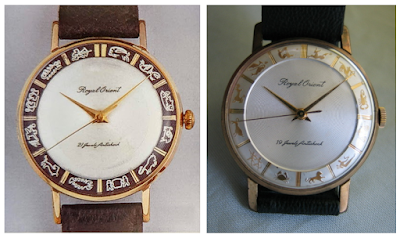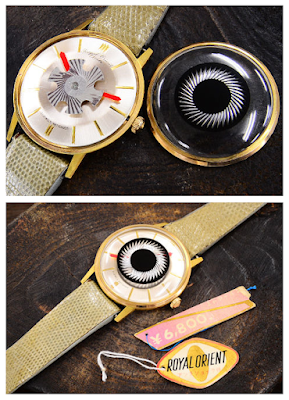Modern Royal Orients managed to gain, throughout their unfortunately short production period, a reputation for high quality and fine finishing. Looking at vintage Royal Orients, their distinctiveness is sometimes not as clear. So this blog post is dedicated to some very unique Royal models of old (Late 1950s, to be precise) – ones whose special flair cannot be denied.
Take these two innocent-looking pieces, in the picture above. Not so innocent when looked at more closely – the one on the left has some pretty intricate circular texture on the lighter part of its dial. The one on the right is encircled with a "wrinkled" textured gold leaf, providing a suitably fancy background for the hour markers.
Orient
did not invent these design elements. Take, for example, two contemporary high-end
models from competing Japanese brands: The Citizen Deluxe boasts a two-tone,
"tuxedo" dial, while the Seiko Cronos features some delicate patterns
on the inner dial as well as the hour track.
Orient
did, however, go to lengths to deliver some unique twists on these common
themes. Here are two very rare designs, offering unusual dial designs.
Or,
if tuxedo dials are your thing, here are two variations on this concept. The
one on the left is presented with the then-common proportions, having a thinner
outer white section, making the dial look bigger. The model on the right – the "Royal
Orient Highlight" – dares to be different by giving the white a little
more space. This actually makes for a very eye-catching appearance, and is the
inspiration for the modern reissue fondly known as the Oreo.
Looking for yet bolder stuff? Then how about these two crazy watches. Complete with standout dials and matching straps, they take the concept of Royal Orient to extravagant extremes.
Not
so bold, but very elaborate, are these astrologically themed models featuring
the twelve signs of the zodiac on the circumference of the dial. Keep in mind
these watches were around 35mm in diameter, so these illustrations are tiny! They
do add a lot of character and interest to the dial, though.
Last but not least, and one of my favorite Royal Orient designs, is this "mystery dial" model. Here, a black disc with diagonal cuts covers the middle of the dial. Instead of a second hand, you have a rotating plate with oppositely running diagonal lines. When the watch is running, the diagonals combine to create a unique radiating effect. You can watch a video of this effect, here!
Pictures
that appear on this post were taken from various sale ads and the 1999 Orient
Watch Catalog book.














